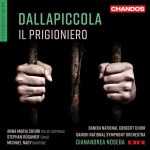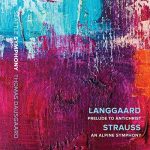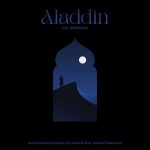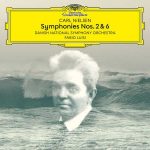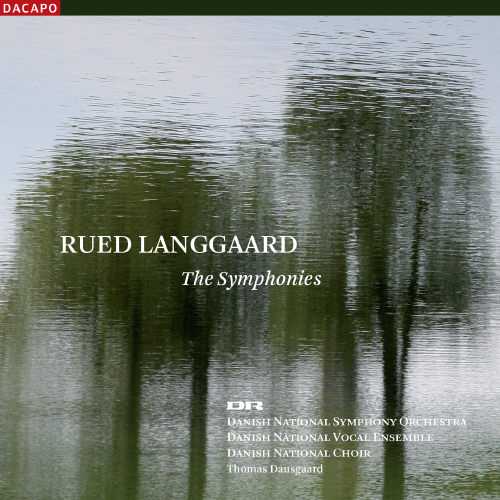
Composer: Rued Langgaard
Performer: Danish National Concert Choir, Danish National Vocal Ensemble
Orchestra: Danish National Symphony Orchestra
Conductor: Thomas Dausgaard
Audio CD
Number of Discs: 7
Format: FLAC (tracks)
Label: Dacapo
Size: 8.27 GB
Recovery: +3%
Scan: yes
Symphony No. 1 “Klippepastoraler” (1908-11)
01. I. Brændinger og Solglimt. Maestoso
02. II. Fjeldblomster. Lento
03. III. Sagn. Lento misterioso
04. IV. Opad Fjeldet. Marcato
05. V. Livsmod. Maestoso allargando – Entusiactico maestoso
Symphony No. 2 “Vårbrud” Original version (1912-14)
06. I. Allegro con anima – Lento – Con moto – Tempo primo – Maestoso festivo alla marcia
07. II. Lento religioso quasi adagio
08. III. Molto con moto (with soprano solo)
Symphony No. 3 “Ungdomsbrus – La melodia” (1915-16, rev. 1925-33)
09. I. Poco animato festivo – Lento (Cadence) – Animato festivo (Tempo primo)
10. II. Grave mastoso – Lento misterioso
11. III. Allegro ma non troppo – Più lento – Vivace
Symphony No. 4 “Løvfald” (1916, rev. 1920)
12. I. Fortvivlet skovbrus: Allegro –
13. II. Solstrejf (Glimpses of sun): Quasi allegretto –
14. III. Allargando espansivo –
15. IV. Torden: Allegro –
16. V. Più lento –
17. VI. Allegretto pastorale –
18. VII. Høstligt!: Allegro con moto –
19. VIII. Træt: Poco adagio –
20. IX. Fortvivlelse: Allegro appassionato –
21. X. Tranquillo –
22. XI. Comodo sempre –
23. XII. Søndag-morgen-klokkerne: Sostenuto pesante –
24. XIII. Forbi!: Più con moto
Symphony No. 5 (Version I) (1917-18/1926)
25. I. Lento misterioso (Introduzione) – Allegro fiero –
26. II. Lento –
27. III. Allegro fiero –
28. IV. Lento misterioso
Symphony No. 5 (Version II) “Steppenatur” (1917-18/1920/1931)
29. I. “Sonate”: Lento misterioso – Fiero pesante preciso –
30. II. Florido –
31. III. Pesante –
32. IV. Coda: “Sonate” con variazioni: Fiero pesante –
33. V. Andante
Symphony No. 6 “Det himmelrivende”
34. I. Thema (Versione I)
35. II. Thema (Versione II)
36. III. Var. I (Introduzione)
37. IV. Var. II (Fuga)
38. V. Var. III (Toccata)
39. VI. Var. IV (Sonata)
40. VII. Var. V (Coda)
Symphony No. 7 (version 1926) (1925-26)
41. I. Maestoso fiero
42. II. Allegro moderato maestoso
43. III. Scherzoso grazioso
44. IV. Fastoso allegro
Symphony No. 8 “Minder ved Amalienborg” (1926-28, rev. 1929-34)
45. I. Maestoso pomposo
46. II. Molto vivace
47. III. Molto elegiaco – Allegro maestoso serioso
48. IV. Finale: Moderato sostenuto – Allegro moderato festivo
Symphony No. 9 “Fra Dronning Dagmars by” (1942)
49. I. Queen Dagmar sails to Ribe. Molto allegro
50. II. The Dance at Riberhus. Grandezza
51. III. Ribe Cathedral. Lento
52. IV. Finale. The turbulent life of the past. Molto allegro
Symphony No. 10 “Hin Torden-bolig” (1944-45)
53. Symphony No. 10 “Hin Torden-bolig” (1944-45)
Symphony No. 11 “Ixion” (1944-45)
54. Symphony No. 11 “Ixion” (1944-45)
Symphony No. 12 “Hélsingeborg” (1946)
55. Symphony No. 12 “Hélsingeborg” (1946)
Symphony No. 13 “Undertro” (1946-47)
56. I. Ret hurtigt –
57. II. Andante –
58. III. Lidt hurtigere –
59. IV. Langsomt – Temmelig hurtigt –
60. V. Samme tempo (vildt) –
61. VI. Elegant! –
62. VII. Hurtigere
Symphony No. 14 “Morgenen” (1947-48/1951)
63. I. Indledningsfanfare
64. II. Upåagtede morgenstjerner
65. III. Marmorkirken ringer
66. IV. De trætte står op til livet
67. V. Radio-Caruso og tvangsenergi
68. VI. ‘Farmænd’ farer til kontoret
69. VII. Sol og bøgeskov
Symphony no. 15 “Søstormen” (1937/1949)
70. I. Bevæget
71. II. Scherzo
72. III. Adagio funebre
73. VI. Finale. Allegro molto agitato
Symphony No. 16 “Syndflod af Sol” (1950-51)
74. I. Allegro –
75. II. Scherzo –
76. III. Straffedans –
77. IV. Elegi –
78. V. Finale
Orchestral works
79. Drapa (On the Death of Edvard Grieg) (1907, rev. 1909-13)
80. Sphinx (1909-10, rev. 1913)
81. Hvidbjerg-Drapa (1948)
82. Danmarks Radio (1948)
83. Res absùrda!? (1948)
dausgaard_langgaard_symphonies249602.rar – 1.3 GB
dausgaard_langgaard_symphonies249603.rar – 1.2 GB
dausgaard_langgaard_symphonies249604.rar – 1.2 GB
dausgaard_langgaard_symphonies249605.rar – 1.2 GB
dausgaard_langgaard_symphonies249606.rar – 1.3 GB
dausgaard_langgaard_symphonies249607.rar – 1.2 GB
With his symphonies the Danish composer Rued Langgaard (1893-1952) offered 16 vastly different versions of what a symphony can be. His captivating, complex genius made room for all conceivable idioms and a wealth of styles ranging from the grandiosely Late Romantic to the purest Absurdism. This box is the first collected recording of Langgaard’s 16 symphonies based on the critical edition of the scores; recordings which demonstrate, with spectacular sound quality, Langgaard’s masterly grasp of the orchestra and his ecstatic view of art.
10/10 – Artistic & Sound Quality – Langgaard was out of his mind. Was he a crazy genius, or just plain crazy? It’s hard to say. His 16 symphonies range in length from one hour (No. 1) to slightly more than six minutes (No. 11). There’s a concertante work for solo piano, chorus, and orchestra (No. 3), music of Straussian refulgence (No. 6 “The Heaven-Rending”), some quirky faux Mendelssohn (Nos. 8 and 9), and lots of nature poetry (Nos. 2, 4, 5, 15, and 16). Most of the works have fanciful titles, ranging from No. 10 “Yon Hall of Thunder” to the religious mysticism of “Belief in Wonders” (No. 13), to No. 14’s individual movements, such as “Dads rush to the office” and “Radio-Caruso and forced energy”.
God only knows what all of it means, but one thing is certain: it’s all tremendously entertaining and never dull. The individual discs in this set have all been issued previously, most of them welcomed here enthusiastically. Thomas Dausgaard and his team deliver uniformly excellent performances captured in first-rate SACD stereo sonics. The packaging in this boxed set is really classy, with slip-cases that unfold when the top is opened, and a neatly printed booklet with informative notes and translations of the sung texts that stores in its own compartment. It’s great to see a national label working so hard and so successfully to preserve its cultural heritage and disseminate it abroad. This project both deserves and will reward your support. — ClassicsToday.com, David Hurwitz, February 19, 2009
At one time, many music lovers and record collectors, including myself, believed that the record companies were archivists who (I say who because we thought of them as people), from the beginning of the 20th century had recorded and preserved the art of both performer and composer for the present and for posterity. There were performers whose name on the label, regardless of repertoire, translated to money in the bank, particularly for EMI, RCA and Columbia who had just about everyone and everybody of significance under contract.
As CD sales diminish, the majors’ output is almost exclusively artist driven. Today, it is the smaller, lesser known companies that explore new repertoire played by musicians who know and illuminate the scores. Except for Naxos, Chandos, and some others who conscientiously record new repertoire, companies, by and large, are merely replacing familiar repertoire with new performances. To record and issue works by obscure composers amounts to artistic heroism, no matter how they are funded. Such an undertaking is this omnibus collection of orchestral works by Rued Langgaard assembled from performances recorded from 1998 to 2008.
The ninth edition of The International Cyclopedia of Music and Musicians (1964, completely revised) has no entry for Rued Langgaard, the Danish composer who lived from 1893 to 1952. It does mention his father, Siegfried, a pianist and composer who had studied with Franz Liszt. Siegfried, it seems, was also immersed in Theosophy, a religious philosophy based on meditation and mysticism, which in turn was deeply embraced by Rued. His music attempts and, depending on the listener’s frame of mind, succeeds in conveying his belief in dimensional realities beyond empirical perceptions.
Langgaard was an ingenuously inventive and highly skilled composer and orchestrator. He was not a Stravinsky, a Schoenberg or a Shostakovich but his lack of originally is compensated by an ingenious and inspired invention within the established Late Romantic style.
His first symphony, written in 1911, was premiered by the Berlin Philharmonic Orchestra conducted by Max Fiedler. This hour-long work is already indicative of his later symphonic development and his individual rhapsodic, drama driven output, sounding for all the world like epic film scores which clearly puts him ahead of his time. This is certainly not a deprecating characterisation but these are the impressions of today, not then. A group of five named orchestral pieces of special character, deeply moving in the Liszt-Wagner genre, round out the collection.
Will Rued Langgaard’s career now take off? Will his symphonies become standard repertoire? Will musical dictionaries now enlarge their coverage? Will we hear his tunes whistled in the subway? Not a chance. But by the same token I commend the colossal and patient undertaking by DACAPO to bring Langgaard’s music to our attention in such superlative performances as these and their many other CDs and DVDs of the music of this undeservedly obscure composer.
This set is a generous appetiser. In addition to his symphonic scores, Langgaard wrote operas, music for the stage, chamber music including string quartets, etc.
